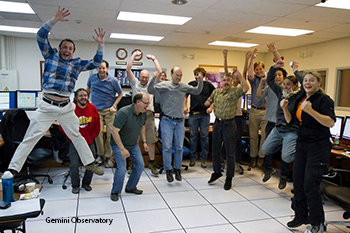
The GPI integration team celebrates after obtaining first light images at the Gemini South telescope control room in Chile.
As the era of known extrasolar planets enters its third decade, scientists are developing new instrumentation and techniques to find even more of these small, distant objects—and perhaps even take a look at their weather.
Researchers at the 8-m Gemini South telescope in Chile recently deployed a new instrument with powerful adaptive optics tailored for the specialized search. The Gemini Planet Imager or GPI (pronounced “gee-pie”) has a 2.4-cm-wide mirror supported by a 64 x 64 array of tiny actuators, each with a 400-μm pitch.
According to GPI team leader Bruce Macintosh of Stanford University and Lawrence Livermore National Laboratory (U.S.A.), the instrument will work in the intermediate area between two main techniques of exoplanet detection. The radial-velocity method of planet-hunting, which measures the gravitational tug of small bodies on their parent star, has a bias toward close-in bodies that orbit the star in a matter of days. Direct imaging, which blocks out the light from the central star in a potential planetary system, is biased toward the most far-out bodies.
The GPI team will begin a large-scale planet-hunting survey in the second half of this year. Speaking at this week's meeting of the American Astronomical Society in National Harbor, Md., Macintosh says he expects the instrument to find 30 to 50 new exoplanets, based on previous surveys.
Other scientists are now studying other worlds in sufficient detail to distinguish possible weather on them. Although planets and brown dwarfs—balls of gas that too small and cool to sustain hydrogen fusion—appear as points of light and not extended disks like solar-system objects, researchers can deduce that they have shifting cloud cover because of their short-term variations, sometimes over a few hours.
Aren Heinze of Stony Brook University (U.S.A.) found these variations in 21 of the 44 brown dwarfs he studied with the Spitzer Space Telescope. Adam Burgasser of the University of California at San Diego (U.S.A.) found one brown dwarf, catalogued as Luhman 16b, that may have 40 to 60 percent cloud coverage.
Veteran planet hunter Geoffrey Marcy of the University of California at Berkeley measured the sizes and densities of 42 exoplanets discovered by the Kepler infrared spacecraft. Bodies of less than four Earth radii in size have rocky cores possibly surrounded by water; larger bodies are more likely to be less dense due to outer layers of hydrogen and helium.
